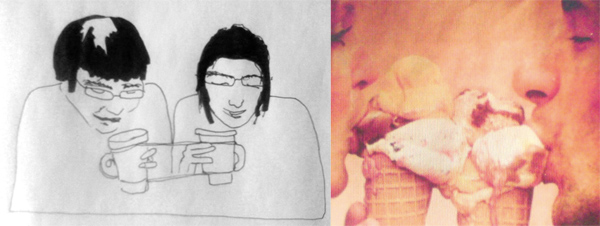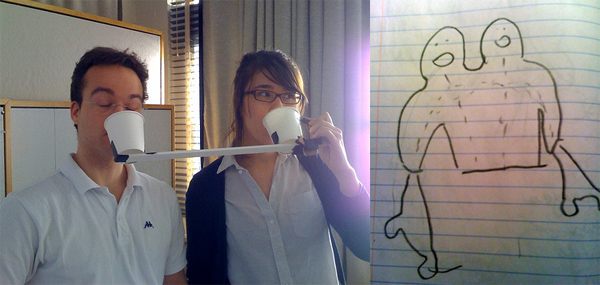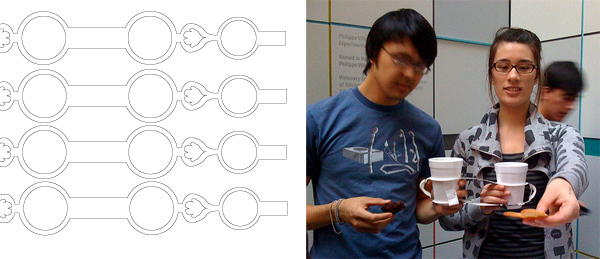Experiments in connected tableware
February 17th, 2009Tags: collision, persuasive design, tableware, vap
Instead of trying to replace language with flavour, I did some experiments with connected tableware, like the first double-cup prototype we did in class. The connected cup requires two drinkers to drink simultaneously, which does not communicate taste, but does require the participants to both engage in drinking simultaneously, lest they spill a drink all over themselves.

Other options for connected consumption would be connected ice cream cones, specific connected cups: beer glasses, coffee cups, etc., connected silverware, connected plates and bowls. However, it must be kept in mind that the container and its intended contents ideally would not only enable but dictate a shared flavour experience.
During the first lecture Daniel and I proposed a variety of connected objects, and we included a first prototype of the cup, as well as a connected fork and connected spoons.

This double cup only has one handle, making one person the operator of the cup whereas the other is subjugated to drink whenever the cup nears.
During the Valentine’s tea at the Media Lab, I brought in a second prototype of the connected cup, this one attached together with laser cut poster board. The poster board was strong enough not to let the cups move freely, but flexible enough not to cause too much spilling.

On the left is the design used for the double cup handles.
I used the cup with 3 people I already knew, and that was a pity. It would have been nicer to have double cups be the only cups provided at the tea, as well as have all tea served in the double cups, so you would have to share with the stranger who happened to be next in line with you. The persuasive nature of the object is then partially provided by the servers, and not just by the object itself. After all, alone you could simply fill one cup.
At some point I used the cup with Elliott Hedman, graduate student in the Affective Computing group at the Media Lab, while he was talking to his supervisor Roz Picard. I was listening to him talk, and at the same time trying to drink my tea. However, each time I brought the cup to my lips for a sip, Elliott would have to stop talking and drink as well. Roz immediately thought it would be a useful tool to use in her autism research, to help guide autistic people in their conversation.
Whether or not that would be the best way to give subtle hints remains to be seen. Next Saturday I will try to make some ceramic versions of the cups, and also start thinking about how else to deal with the persuasion. The cup could be more communicative without adding a bunch of hardware– I’ll see if I can figure it out.
